Comparative Analysis of Accounting Theories: Qantas & Virgin Australia
VerifiedAdded on 2020/03/01
|16
|2251
|223
Report
AI Summary
This report provides a comprehensive comparison of the accounting practices of Qantas Airways and Virgin Australia Airlines. It examines the companies' adherence to accounting standards, particularly AASB and Corporations Act 2001, and the application of the prudence concept. The report analyzes key financial data, including total assets, tangible and intangible assets, and depreciation methods. It also explores the rationale for shareholder investment in both airlines, drawing on information from director's reports and CEO statements. The analysis covers revenue recognition, asset valuation, and the impact of accounting policies on financial performance, providing a detailed overview of the financial reporting frameworks employed by both companies. The report concludes with a summary of the key findings and references relevant literature.
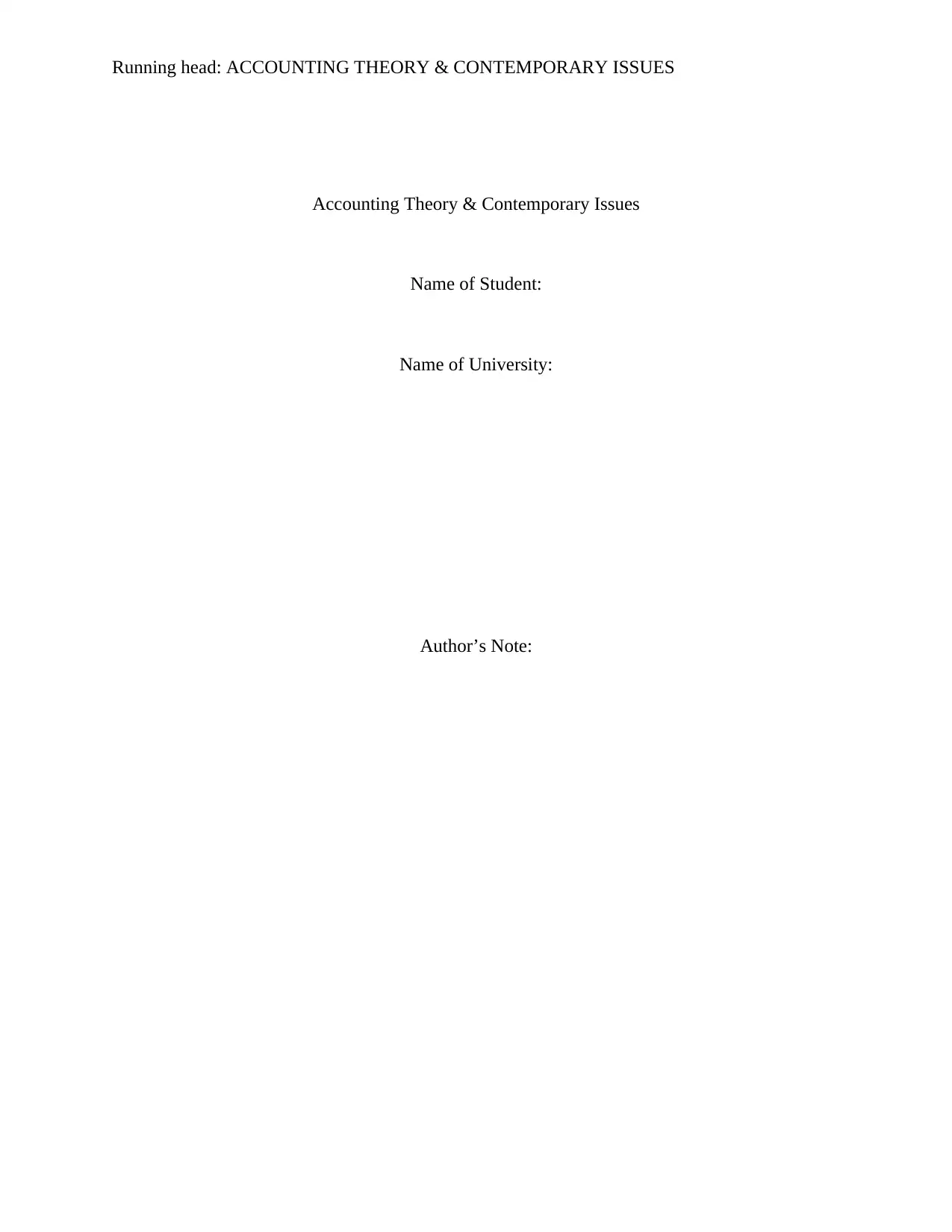
Running head: ACCOUNTING THEORY & CONTEMPORARY ISSUES
Accounting Theory & Contemporary Issues
Name of Student:
Name of University:
Author’s Note:
Accounting Theory & Contemporary Issues
Name of Student:
Name of University:
Author’s Note:
Paraphrase This Document
Need a fresh take? Get an instant paraphrase of this document with our AI Paraphraser

1ACCOUNTING THEORY & CONTEMPORARY ISSUES
Executive Summary
The study is intended to important concept which has been seen to be related to the show the
accounting methods adopted by Virgin Australia Airlines and Qantas Airways and various types
of the other notes from the Auditors Report, Remuneration Report and Financial reports. The
final section of the section of the study has been taken into account to discuss on the rationale for
the shareholders to invest. The main accounting standard has been identified with AASB and
Corporations Act 2001. The chief aspect of prudence has been discerned with the delay in the
recognition of the “AASB 15 Revenue from Contracts with Customers (AASB 15)” and “AASB
16 Leases (AASB 16)”. In terms of Qantas Airways Ltd, the assets is categorised as per the
assets held for sale and measured in terms of the fair value less cost of selling. The financial
statements preparation for Virgin Australia Airlines with the assets which are not held for the
assessment based on leases to be categorised at fair value. The important aspect of Qantas Group
has been seen with the decreased recognition as per straight line basis for PPE except for
freehold land. The depreciation and amortisation of the Virgin Airlines is taken into
consideration as per the date they have been classified as being held for sale. The reduction on
the PPE is stated as per cost less “accumulated depreciation and impairment losses”.
Executive Summary
The study is intended to important concept which has been seen to be related to the show the
accounting methods adopted by Virgin Australia Airlines and Qantas Airways and various types
of the other notes from the Auditors Report, Remuneration Report and Financial reports. The
final section of the section of the study has been taken into account to discuss on the rationale for
the shareholders to invest. The main accounting standard has been identified with AASB and
Corporations Act 2001. The chief aspect of prudence has been discerned with the delay in the
recognition of the “AASB 15 Revenue from Contracts with Customers (AASB 15)” and “AASB
16 Leases (AASB 16)”. In terms of Qantas Airways Ltd, the assets is categorised as per the
assets held for sale and measured in terms of the fair value less cost of selling. The financial
statements preparation for Virgin Australia Airlines with the assets which are not held for the
assessment based on leases to be categorised at fair value. The important aspect of Qantas Group
has been seen with the decreased recognition as per straight line basis for PPE except for
freehold land. The depreciation and amortisation of the Virgin Airlines is taken into
consideration as per the date they have been classified as being held for sale. The reduction on
the PPE is stated as per cost less “accumulated depreciation and impairment losses”.
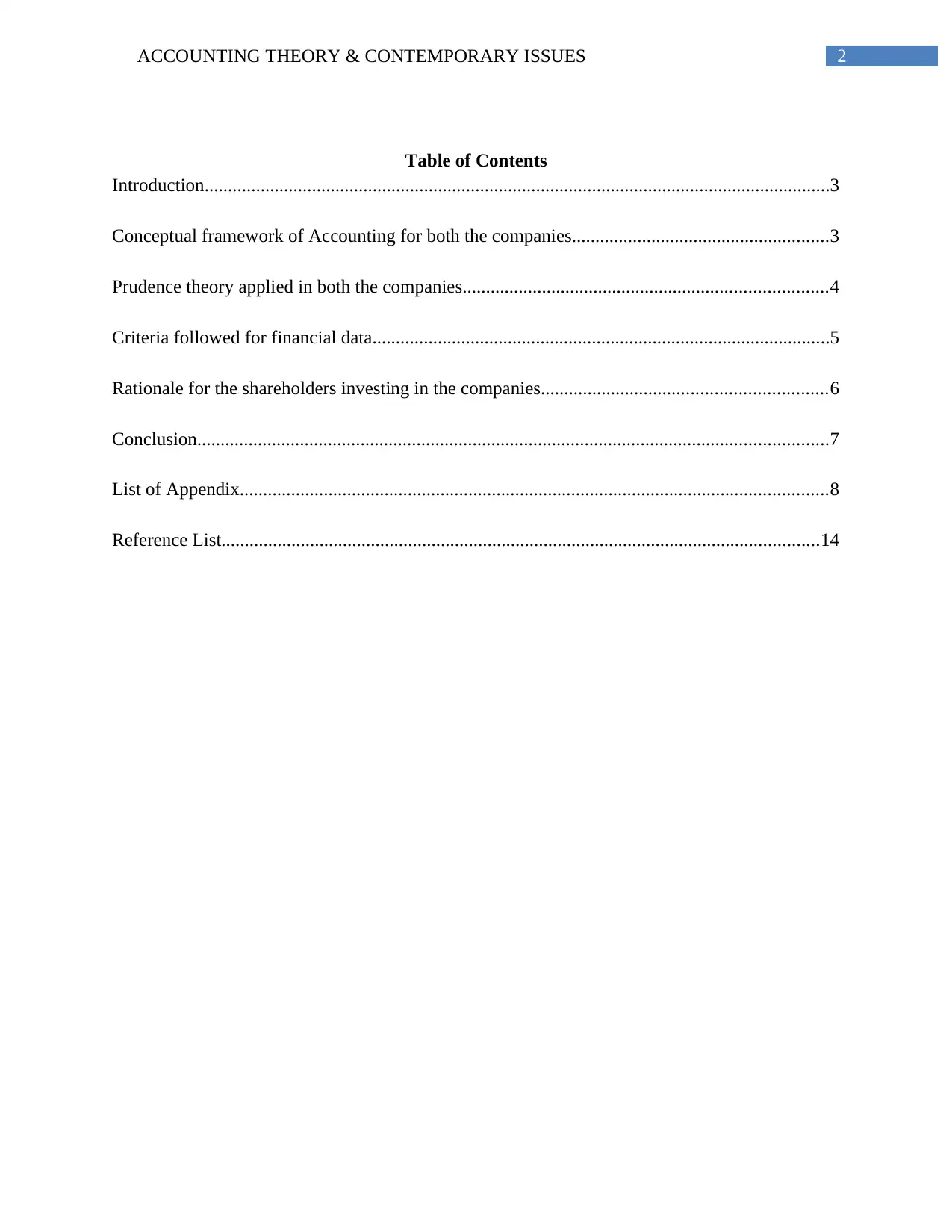
2ACCOUNTING THEORY & CONTEMPORARY ISSUES
Table of Contents
Introduction......................................................................................................................................3
Conceptual framework of Accounting for both the companies.......................................................3
Prudence theory applied in both the companies..............................................................................4
Criteria followed for financial data..................................................................................................5
Rationale for the shareholders investing in the companies.............................................................6
Conclusion.......................................................................................................................................7
List of Appendix..............................................................................................................................8
Reference List................................................................................................................................14
Table of Contents
Introduction......................................................................................................................................3
Conceptual framework of Accounting for both the companies.......................................................3
Prudence theory applied in both the companies..............................................................................4
Criteria followed for financial data..................................................................................................5
Rationale for the shareholders investing in the companies.............................................................6
Conclusion.......................................................................................................................................7
List of Appendix..............................................................................................................................8
Reference List................................................................................................................................14
⊘ This is a preview!⊘
Do you want full access?
Subscribe today to unlock all pages.

Trusted by 1+ million students worldwide
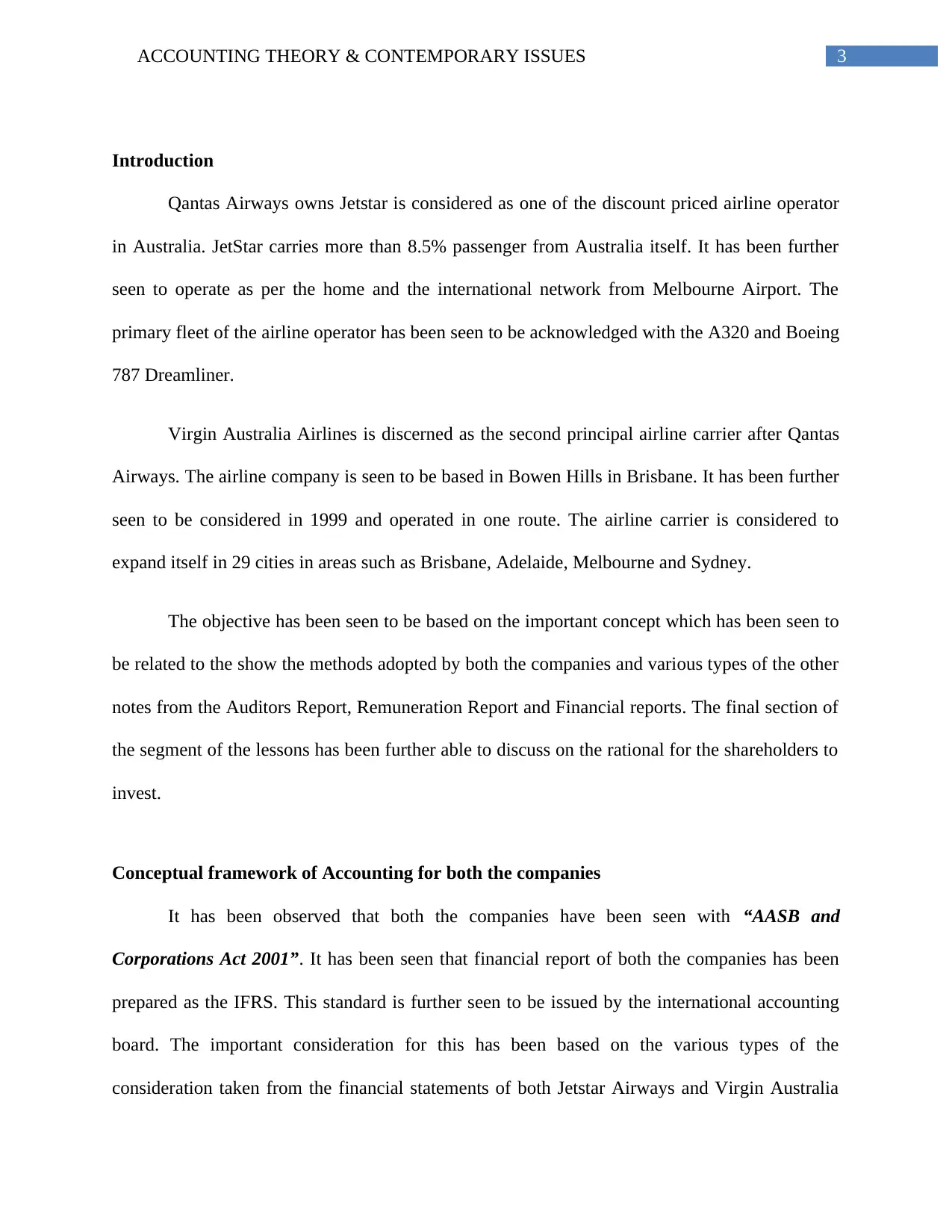
3ACCOUNTING THEORY & CONTEMPORARY ISSUES
Introduction
Qantas Airways owns Jetstar is considered as one of the discount priced airline operator
in Australia. JetStar carries more than 8.5% passenger from Australia itself. It has been further
seen to operate as per the home and the international network from Melbourne Airport. The
primary fleet of the airline operator has been seen to be acknowledged with the A320 and Boeing
787 Dreamliner.
Virgin Australia Airlines is discerned as the second principal airline carrier after Qantas
Airways. The airline company is seen to be based in Bowen Hills in Brisbane. It has been further
seen to be considered in 1999 and operated in one route. The airline carrier is considered to
expand itself in 29 cities in areas such as Brisbane, Adelaide, Melbourne and Sydney.
The objective has been seen to be based on the important concept which has been seen to
be related to the show the methods adopted by both the companies and various types of the other
notes from the Auditors Report, Remuneration Report and Financial reports. The final section of
the segment of the lessons has been further able to discuss on the rational for the shareholders to
invest.
Conceptual framework of Accounting for both the companies
It has been observed that both the companies have been seen with “AASB and
Corporations Act 2001”. It has been seen that financial report of both the companies has been
prepared as the IFRS. This standard is further seen to be issued by the international accounting
board. The important consideration for this has been based on the various types of the
consideration taken from the financial statements of both Jetstar Airways and Virgin Australia
Introduction
Qantas Airways owns Jetstar is considered as one of the discount priced airline operator
in Australia. JetStar carries more than 8.5% passenger from Australia itself. It has been further
seen to operate as per the home and the international network from Melbourne Airport. The
primary fleet of the airline operator has been seen to be acknowledged with the A320 and Boeing
787 Dreamliner.
Virgin Australia Airlines is discerned as the second principal airline carrier after Qantas
Airways. The airline company is seen to be based in Bowen Hills in Brisbane. It has been further
seen to be considered in 1999 and operated in one route. The airline carrier is considered to
expand itself in 29 cities in areas such as Brisbane, Adelaide, Melbourne and Sydney.
The objective has been seen to be based on the important concept which has been seen to
be related to the show the methods adopted by both the companies and various types of the other
notes from the Auditors Report, Remuneration Report and Financial reports. The final section of
the segment of the lessons has been further able to discuss on the rational for the shareholders to
invest.
Conceptual framework of Accounting for both the companies
It has been observed that both the companies have been seen with “AASB and
Corporations Act 2001”. It has been seen that financial report of both the companies has been
prepared as the IFRS. This standard is further seen to be issued by the international accounting
board. The important consideration for this has been based on the various types of the
consideration taken from the financial statements of both Jetstar Airways and Virgin Australia
Paraphrase This Document
Need a fresh take? Get an instant paraphrase of this document with our AI Paraphraser
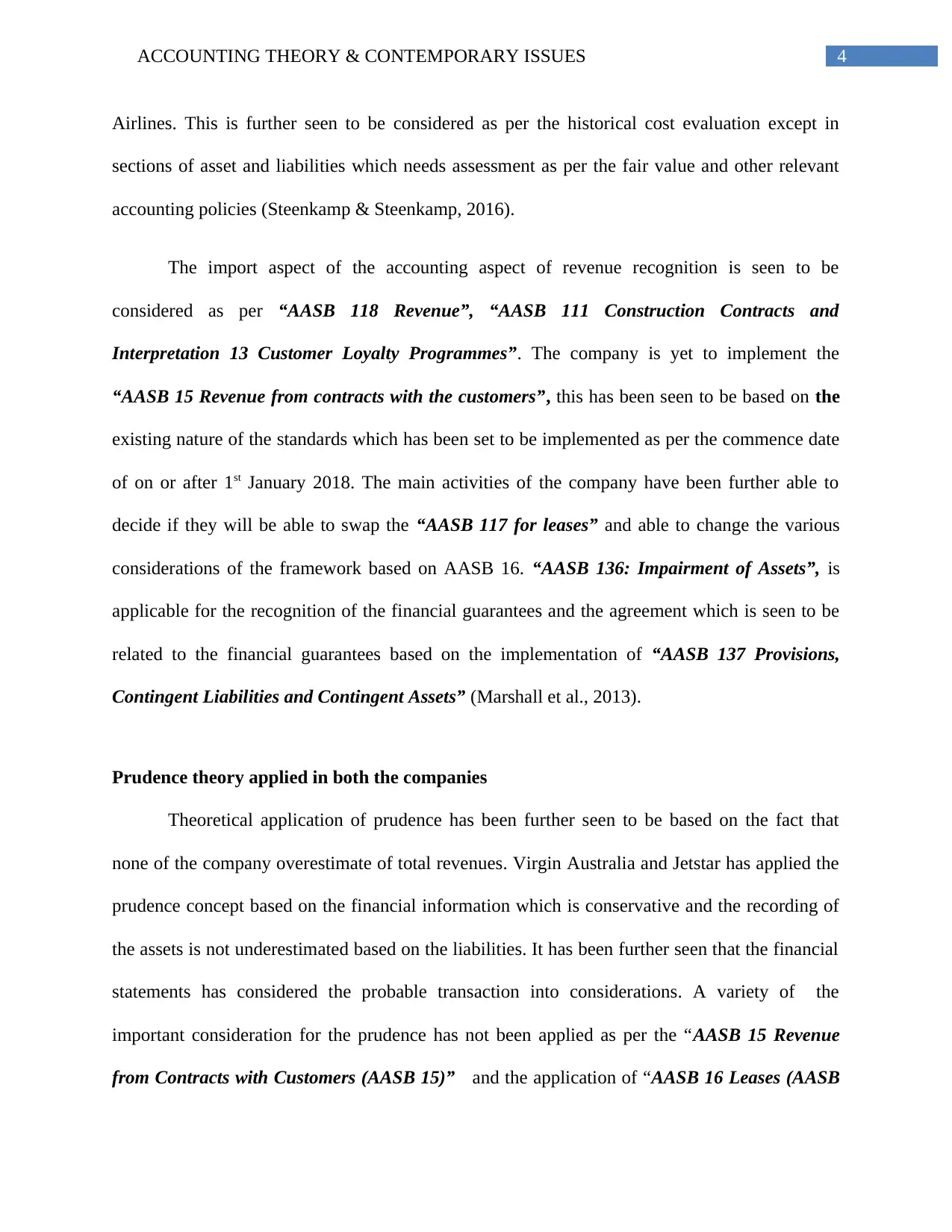
4ACCOUNTING THEORY & CONTEMPORARY ISSUES
Airlines. This is further seen to be considered as per the historical cost evaluation except in
sections of asset and liabilities which needs assessment as per the fair value and other relevant
accounting policies (Steenkamp & Steenkamp, 2016).
The import aspect of the accounting aspect of revenue recognition is seen to be
considered as per “AASB 118 Revenue”, “AASB 111 Construction Contracts and
Interpretation 13 Customer Loyalty Programmes”. The company is yet to implement the
“AASB 15 Revenue from contracts with the customers”, this has been seen to be based on the
existing nature of the standards which has been set to be implemented as per the commence date
of on or after 1st January 2018. The main activities of the company have been further able to
decide if they will be able to swap the “AASB 117 for leases” and able to change the various
considerations of the framework based on AASB 16. “AASB 136: Impairment of Assets”, is
applicable for the recognition of the financial guarantees and the agreement which is seen to be
related to the financial guarantees based on the implementation of “AASB 137 Provisions,
Contingent Liabilities and Contingent Assets” (Marshall et al., 2013).
Prudence theory applied in both the companies
Theoretical application of prudence has been further seen to be based on the fact that
none of the company overestimate of total revenues. Virgin Australia and Jetstar has applied the
prudence concept based on the financial information which is conservative and the recording of
the assets is not underestimated based on the liabilities. It has been further seen that the financial
statements has considered the probable transaction into considerations. A variety of the
important consideration for the prudence has not been applied as per the “AASB 15 Revenue
from Contracts with Customers (AASB 15)” and the application of “AASB 16 Leases (AASB
Airlines. This is further seen to be considered as per the historical cost evaluation except in
sections of asset and liabilities which needs assessment as per the fair value and other relevant
accounting policies (Steenkamp & Steenkamp, 2016).
The import aspect of the accounting aspect of revenue recognition is seen to be
considered as per “AASB 118 Revenue”, “AASB 111 Construction Contracts and
Interpretation 13 Customer Loyalty Programmes”. The company is yet to implement the
“AASB 15 Revenue from contracts with the customers”, this has been seen to be based on the
existing nature of the standards which has been set to be implemented as per the commence date
of on or after 1st January 2018. The main activities of the company have been further able to
decide if they will be able to swap the “AASB 117 for leases” and able to change the various
considerations of the framework based on AASB 16. “AASB 136: Impairment of Assets”, is
applicable for the recognition of the financial guarantees and the agreement which is seen to be
related to the financial guarantees based on the implementation of “AASB 137 Provisions,
Contingent Liabilities and Contingent Assets” (Marshall et al., 2013).
Prudence theory applied in both the companies
Theoretical application of prudence has been further seen to be based on the fact that
none of the company overestimate of total revenues. Virgin Australia and Jetstar has applied the
prudence concept based on the financial information which is conservative and the recording of
the assets is not underestimated based on the liabilities. It has been further seen that the financial
statements has considered the probable transaction into considerations. A variety of the
important consideration for the prudence has not been applied as per the “AASB 15 Revenue
from Contracts with Customers (AASB 15)” and the application of “AASB 16 Leases (AASB

5ACCOUNTING THEORY & CONTEMPORARY ISSUES
16)”. It is seen to be convinced of replacing the existing standards. For testing the viability of the
various types of the methods, the companies have been able to decide on test the new method for
lease only after 01.01.2019. Other considerations of prudence have been depicted with the
regular review of the assets and in terms of assessment of the decreasing values of these assets.
The most important consideration for prudence is evident among both the companies by writing
off the values in terms of fixed assets (Barker, 2015).
Criteria followed for financial data
Total Assets- The total asset of Qantas Airways is standing at $ 17708m in 2016; however the
entire asset of virgin Australia is seen to be $ 6886.9 m in 2016. In addition to this, Virgin
Australia is not having any amount of the dependent liabilities as on 30 June 2016. In terms of
Qantas Airways Ltd, the assets have been seen to be categorised as per the assets held for sale
and measured in terms of the fair value less cost of selling. The main benefit of Qantas Airways
is seen with the measurement of “fair value of plan assets less the present value”. The different
types of the other consideration has been further seen to be made with the preparation of
financial statements of Virgin Australia Airlines with the assets which are not held for the
assessment based on financial leases to be recognised at fair value (Wan Norhishamuddinet al.,
2015).
Tangible Assets and Intangible Assets- It has been depicted with the recognition of the
intangible and the intangible assets, with the consideration of “non-current tangible assets”,
which are further seen to be regarded for revenue as per the recoverable amount of the assets.
The amortisation is considered as per residual life and useful life as per the date of reporting
(Guthrie & Pang, 2013).
16)”. It is seen to be convinced of replacing the existing standards. For testing the viability of the
various types of the methods, the companies have been able to decide on test the new method for
lease only after 01.01.2019. Other considerations of prudence have been depicted with the
regular review of the assets and in terms of assessment of the decreasing values of these assets.
The most important consideration for prudence is evident among both the companies by writing
off the values in terms of fixed assets (Barker, 2015).
Criteria followed for financial data
Total Assets- The total asset of Qantas Airways is standing at $ 17708m in 2016; however the
entire asset of virgin Australia is seen to be $ 6886.9 m in 2016. In addition to this, Virgin
Australia is not having any amount of the dependent liabilities as on 30 June 2016. In terms of
Qantas Airways Ltd, the assets have been seen to be categorised as per the assets held for sale
and measured in terms of the fair value less cost of selling. The main benefit of Qantas Airways
is seen with the measurement of “fair value of plan assets less the present value”. The different
types of the other consideration has been further seen to be made with the preparation of
financial statements of Virgin Australia Airlines with the assets which are not held for the
assessment based on financial leases to be recognised at fair value (Wan Norhishamuddinet al.,
2015).
Tangible Assets and Intangible Assets- It has been depicted with the recognition of the
intangible and the intangible assets, with the consideration of “non-current tangible assets”,
which are further seen to be regarded for revenue as per the recoverable amount of the assets.
The amortisation is considered as per residual life and useful life as per the date of reporting
(Guthrie & Pang, 2013).
⊘ This is a preview!⊘
Do you want full access?
Subscribe today to unlock all pages.

Trusted by 1+ million students worldwide
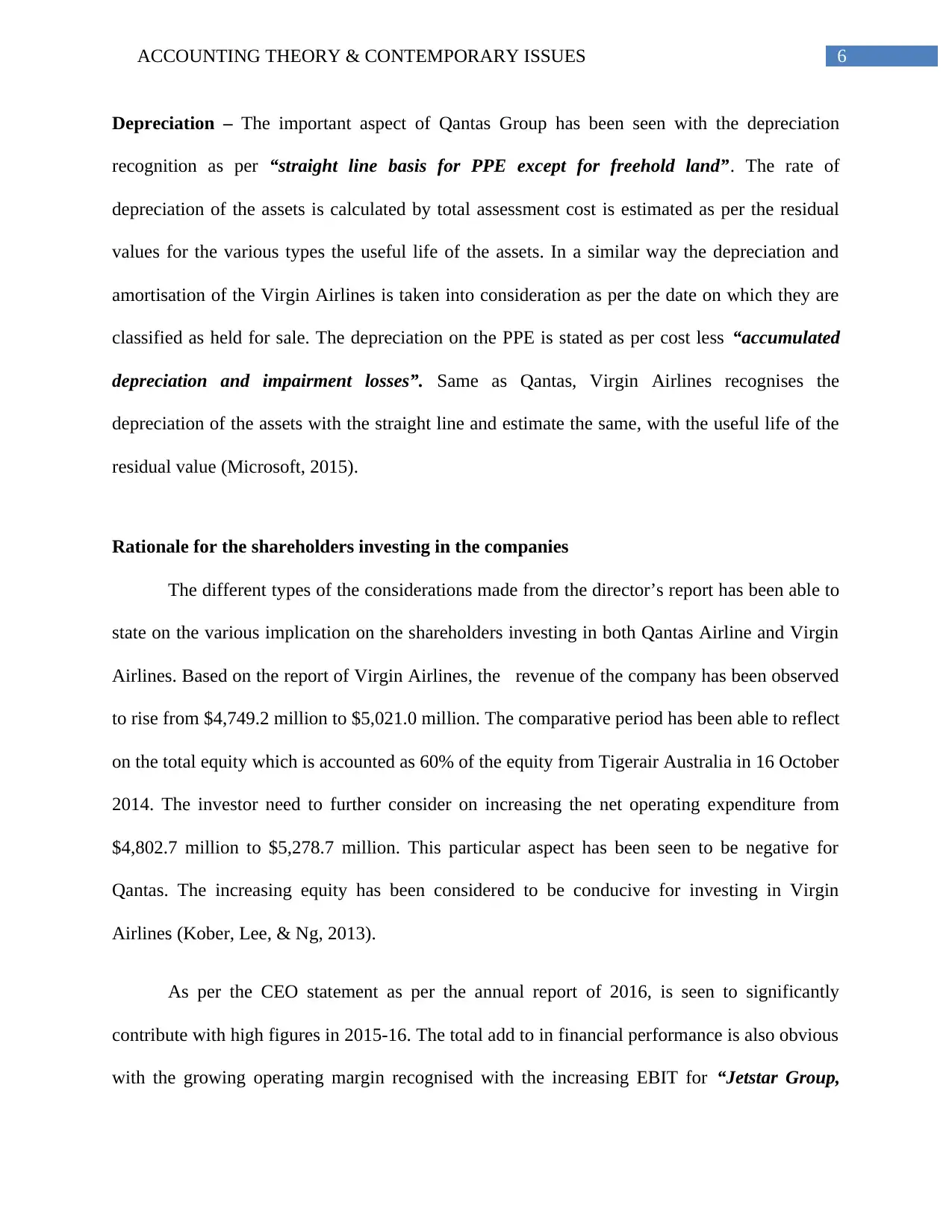
6ACCOUNTING THEORY & CONTEMPORARY ISSUES
Depreciation – The important aspect of Qantas Group has been seen with the depreciation
recognition as per “straight line basis for PPE except for freehold land”. The rate of
depreciation of the assets is calculated by total assessment cost is estimated as per the residual
values for the various types the useful life of the assets. In a similar way the depreciation and
amortisation of the Virgin Airlines is taken into consideration as per the date on which they are
classified as held for sale. The depreciation on the PPE is stated as per cost less “accumulated
depreciation and impairment losses”. Same as Qantas, Virgin Airlines recognises the
depreciation of the assets with the straight line and estimate the same, with the useful life of the
residual value (Microsoft, 2015).
Rationale for the shareholders investing in the companies
The different types of the considerations made from the director’s report has been able to
state on the various implication on the shareholders investing in both Qantas Airline and Virgin
Airlines. Based on the report of Virgin Airlines, the revenue of the company has been observed
to rise from $4,749.2 million to $5,021.0 million. The comparative period has been able to reflect
on the total equity which is accounted as 60% of the equity from Tigerair Australia in 16 October
2014. The investor need to further consider on increasing the net operating expenditure from
$4,802.7 million to $5,278.7 million. This particular aspect has been seen to be negative for
Qantas. The increasing equity has been considered to be conducive for investing in Virgin
Airlines (Kober, Lee, & Ng, 2013).
As per the CEO statement as per the annual report of 2016, is seen to significantly
contribute with high figures in 2015-16. The total add to in financial performance is also obvious
with the growing operating margin recognised with the increasing EBIT for “Jetstar Group,
Depreciation – The important aspect of Qantas Group has been seen with the depreciation
recognition as per “straight line basis for PPE except for freehold land”. The rate of
depreciation of the assets is calculated by total assessment cost is estimated as per the residual
values for the various types the useful life of the assets. In a similar way the depreciation and
amortisation of the Virgin Airlines is taken into consideration as per the date on which they are
classified as held for sale. The depreciation on the PPE is stated as per cost less “accumulated
depreciation and impairment losses”. Same as Qantas, Virgin Airlines recognises the
depreciation of the assets with the straight line and estimate the same, with the useful life of the
residual value (Microsoft, 2015).
Rationale for the shareholders investing in the companies
The different types of the considerations made from the director’s report has been able to
state on the various implication on the shareholders investing in both Qantas Airline and Virgin
Airlines. Based on the report of Virgin Airlines, the revenue of the company has been observed
to rise from $4,749.2 million to $5,021.0 million. The comparative period has been able to reflect
on the total equity which is accounted as 60% of the equity from Tigerair Australia in 16 October
2014. The investor need to further consider on increasing the net operating expenditure from
$4,802.7 million to $5,278.7 million. This particular aspect has been seen to be negative for
Qantas. The increasing equity has been considered to be conducive for investing in Virgin
Airlines (Kober, Lee, & Ng, 2013).
As per the CEO statement as per the annual report of 2016, is seen to significantly
contribute with high figures in 2015-16. The total add to in financial performance is also obvious
with the growing operating margin recognised with the increasing EBIT for “Jetstar Group,
Paraphrase This Document
Need a fresh take? Get an instant paraphrase of this document with our AI Paraphraser
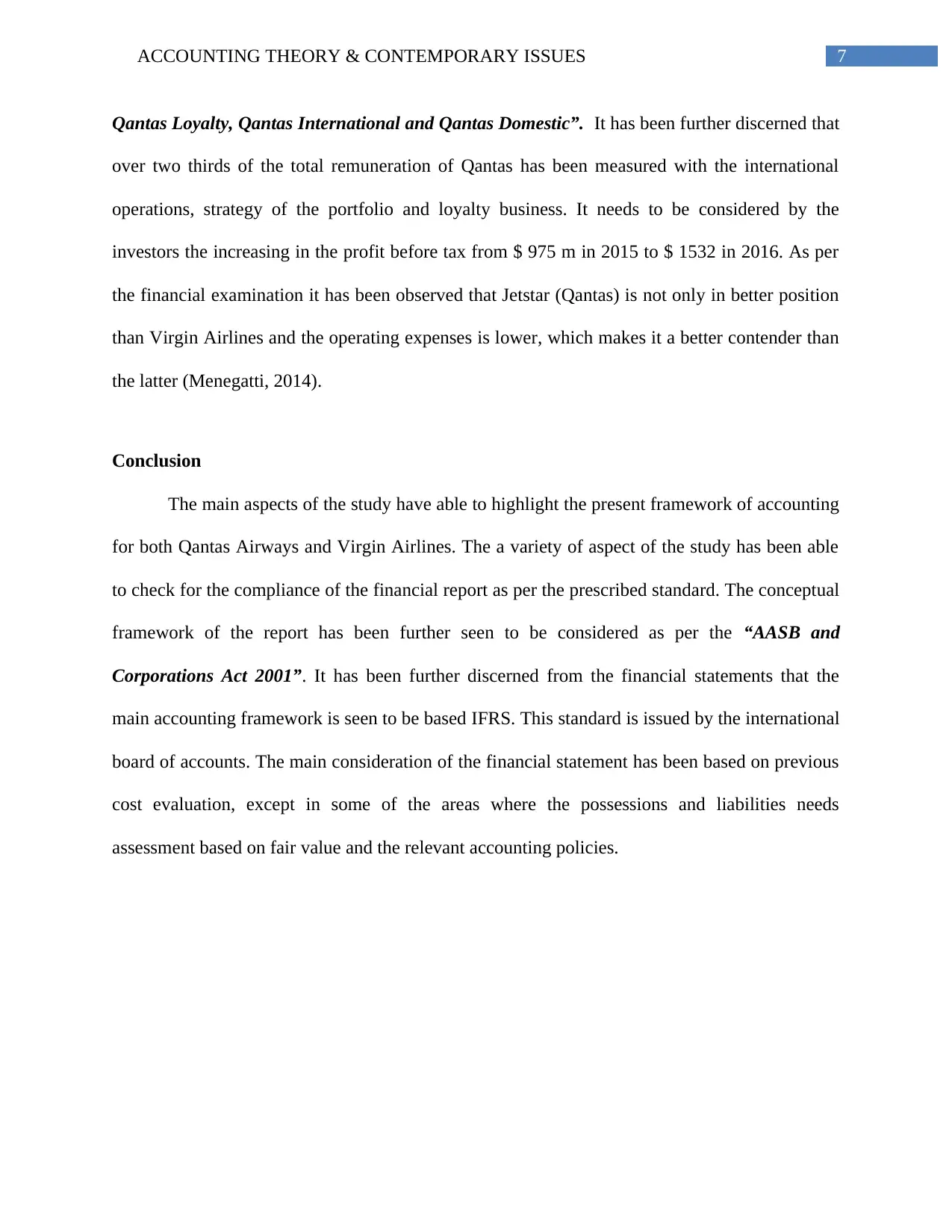
7ACCOUNTING THEORY & CONTEMPORARY ISSUES
Qantas Loyalty, Qantas International and Qantas Domestic”. It has been further discerned that
over two thirds of the total remuneration of Qantas has been measured with the international
operations, strategy of the portfolio and loyalty business. It needs to be considered by the
investors the increasing in the profit before tax from $ 975 m in 2015 to $ 1532 in 2016. As per
the financial examination it has been observed that Jetstar (Qantas) is not only in better position
than Virgin Airlines and the operating expenses is lower, which makes it a better contender than
the latter (Menegatti, 2014).
Conclusion
The main aspects of the study have able to highlight the present framework of accounting
for both Qantas Airways and Virgin Airlines. The a variety of aspect of the study has been able
to check for the compliance of the financial report as per the prescribed standard. The conceptual
framework of the report has been further seen to be considered as per the “AASB and
Corporations Act 2001”. It has been further discerned from the financial statements that the
main accounting framework is seen to be based IFRS. This standard is issued by the international
board of accounts. The main consideration of the financial statement has been based on previous
cost evaluation, except in some of the areas where the possessions and liabilities needs
assessment based on fair value and the relevant accounting policies.
Qantas Loyalty, Qantas International and Qantas Domestic”. It has been further discerned that
over two thirds of the total remuneration of Qantas has been measured with the international
operations, strategy of the portfolio and loyalty business. It needs to be considered by the
investors the increasing in the profit before tax from $ 975 m in 2015 to $ 1532 in 2016. As per
the financial examination it has been observed that Jetstar (Qantas) is not only in better position
than Virgin Airlines and the operating expenses is lower, which makes it a better contender than
the latter (Menegatti, 2014).
Conclusion
The main aspects of the study have able to highlight the present framework of accounting
for both Qantas Airways and Virgin Airlines. The a variety of aspect of the study has been able
to check for the compliance of the financial report as per the prescribed standard. The conceptual
framework of the report has been further seen to be considered as per the “AASB and
Corporations Act 2001”. It has been further discerned from the financial statements that the
main accounting framework is seen to be based IFRS. This standard is issued by the international
board of accounts. The main consideration of the financial statement has been based on previous
cost evaluation, except in some of the areas where the possessions and liabilities needs
assessment based on fair value and the relevant accounting policies.
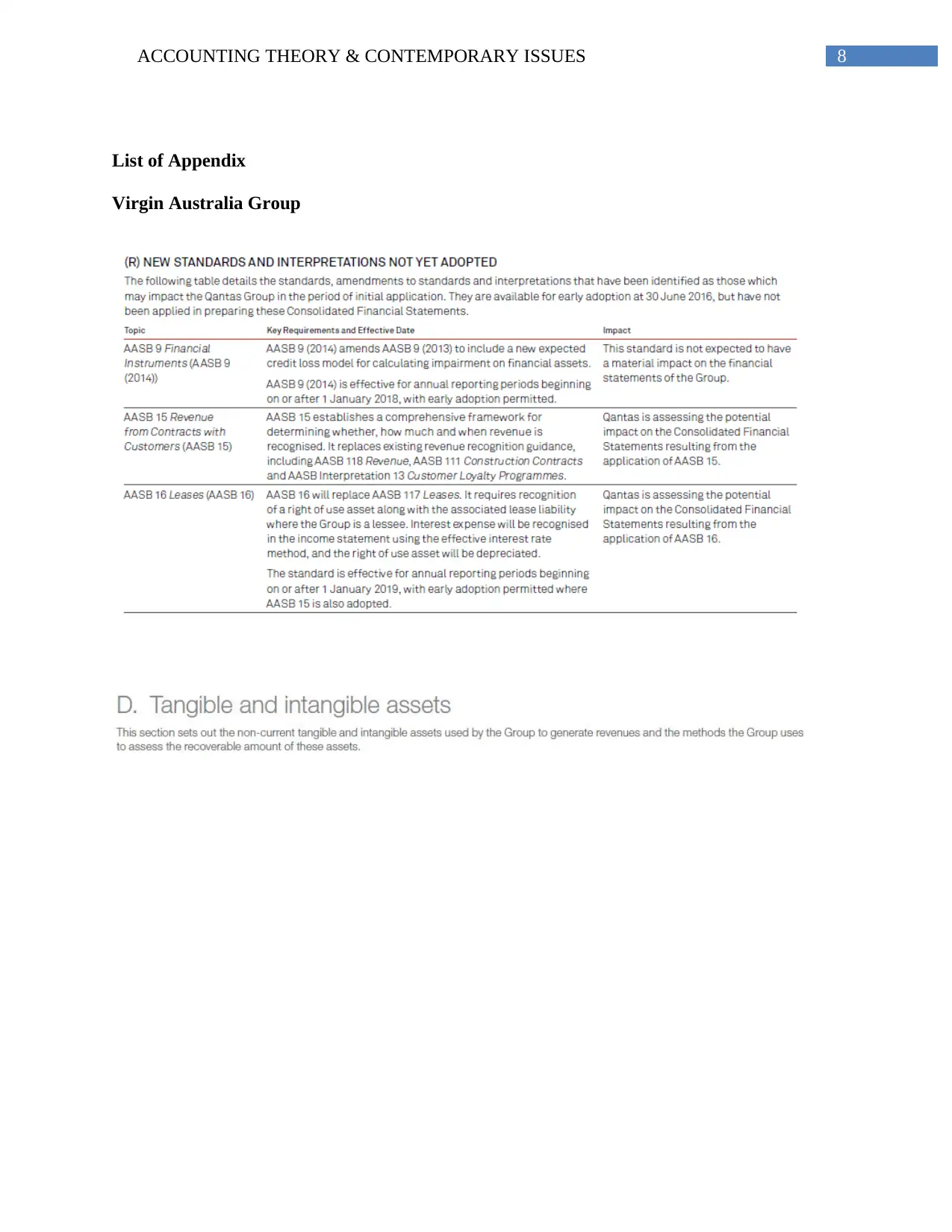
8ACCOUNTING THEORY & CONTEMPORARY ISSUES
List of Appendix
Virgin Australia Group
List of Appendix
Virgin Australia Group
⊘ This is a preview!⊘
Do you want full access?
Subscribe today to unlock all pages.

Trusted by 1+ million students worldwide

9ACCOUNTING THEORY & CONTEMPORARY ISSUES
Paraphrase This Document
Need a fresh take? Get an instant paraphrase of this document with our AI Paraphraser
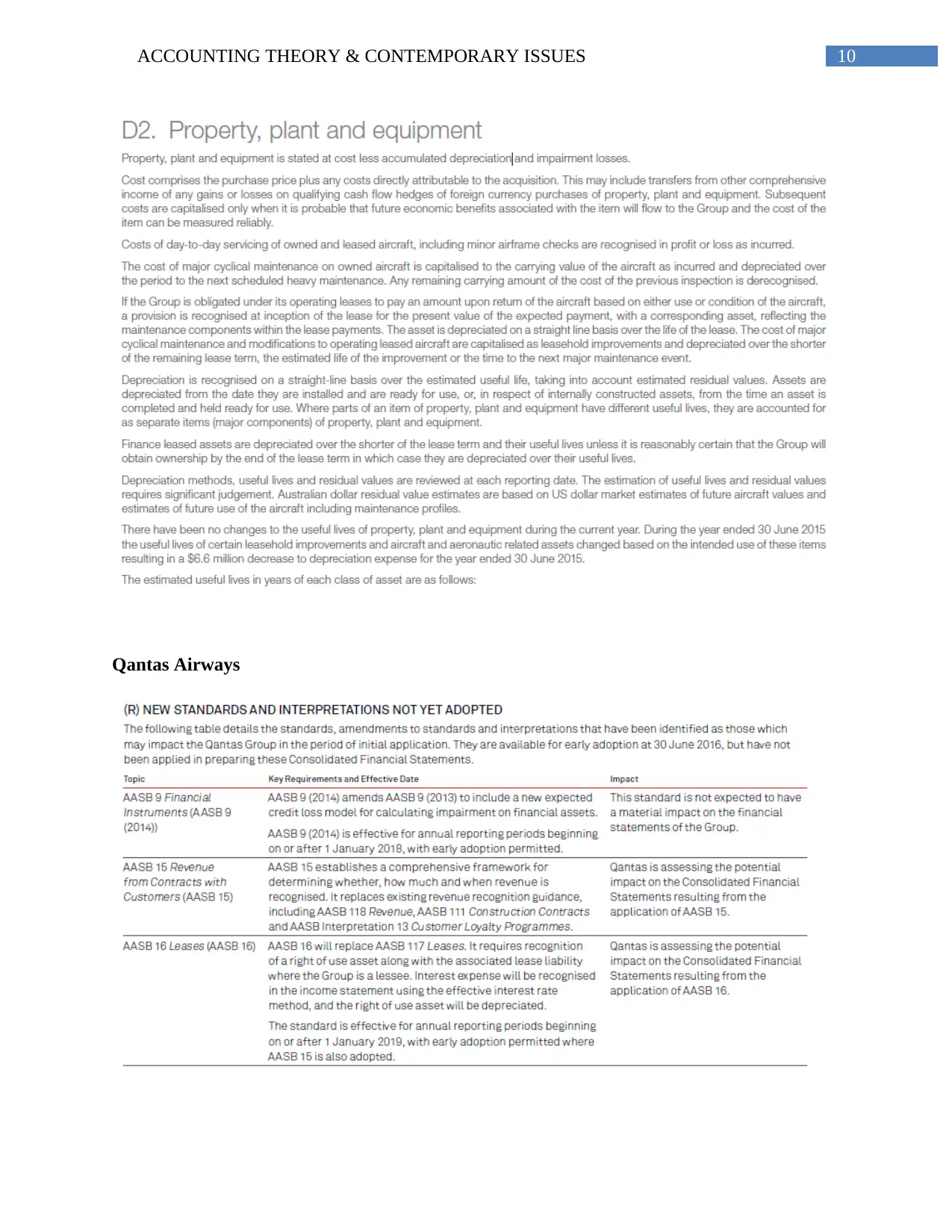
10ACCOUNTING THEORY & CONTEMPORARY ISSUES
Qantas Airways
Qantas Airways
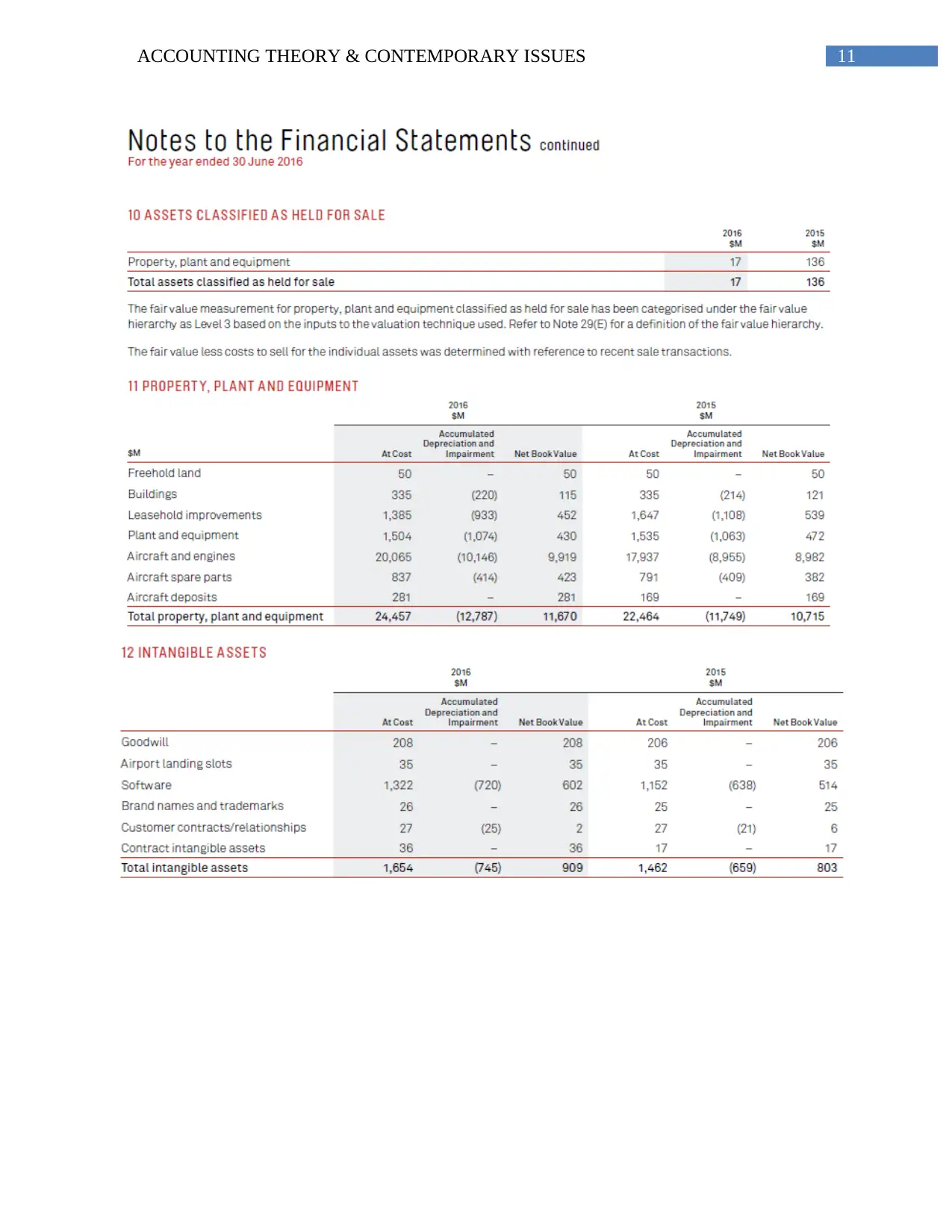
11ACCOUNTING THEORY & CONTEMPORARY ISSUES
⊘ This is a preview!⊘
Do you want full access?
Subscribe today to unlock all pages.

Trusted by 1+ million students worldwide
1 out of 16
Related Documents
Your All-in-One AI-Powered Toolkit for Academic Success.
+13062052269
info@desklib.com
Available 24*7 on WhatsApp / Email
![[object Object]](/_next/static/media/star-bottom.7253800d.svg)
Unlock your academic potential
Copyright © 2020–2025 A2Z Services. All Rights Reserved. Developed and managed by ZUCOL.




